Jambalaya, the name just sounds fun. This is a dish made for a crowd and shows off the best of South Louisiana cuisine. Here is Sweet Daddy D’s Creole Jambalaya, a savory concoction of smoked meats and shrimp with tomatoes, the Trinity, and rice simmered in a rich stock. This Creole version of Jambalaya is a homogeneous combination of flavors where no single ingredient dominates, but all add to the symphony. Commonly referred to as Red Jambalaya, this one-pot dish is simple, delicious, and definitely represents the Creole soul of South Louisiana.
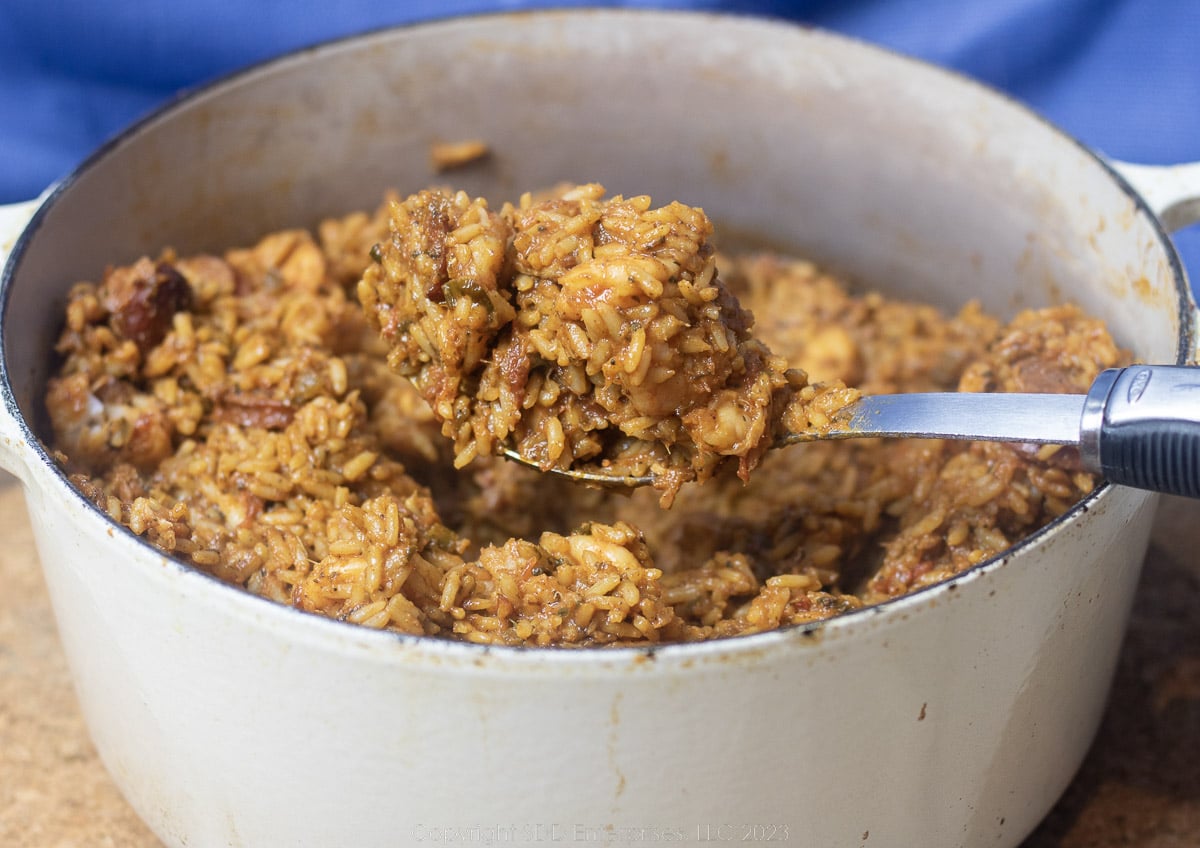
This post is not sponsored, but you will find affiliate links on this page. As an Amazon Associate, I earn from qualifying purchases. The price you pay as a consumer does not change, but I may make a small commission based on your purchase.
If you want to just skip to the recipe, click the "Jump To Recipe" button above or the Recipe link below and you’ll go right there without having to scroll through my article.
Jump to:
What Is Jambalaya?
Jambalaya, like the South Louisiana culture itself, is a merging of cuisines producing something larger than the sum of its parts. Jambalaya is a rice dish that combines elements of African and Spanish influences as well as French and Cajun experiences and methods. Dating back to the earliest settlers and slave communities, the name jambalaya comes from the French word for ham, “jambon” and the African word for rice, “ya”. Throw in the phrase “à la” which, in cooking, means cooked in a particular style or manner and you have the South Louisiana culture represented right on your plate.
Is Jambalaya Cajun or Creole?
The answer to this question is yes. In most cases, the distinction between Cajun and Creole can be a little obscure, but jambalaya makes it simple...there is a Creole version and a Cajun version. Cajun Jambalaya, referred to as brown jambalaya, commonly includes chicken, pork, pork sausage, ham, and/or game, while the Creole version may contain pork sausage, ham, and shrimp but always tomatoes. It's often called red jambalaya. As with most traditional dishes, 18th Century Cajun and Creole cooks adapted recipes and methods to available ingredients. The Port of New Orleans provided Creole cooks with a wider range of ingredients and flavors than the Bayous and plains of the Cajun cooks. These two types of Jambalaya create two distinctive flavors, but their subtle differences characterize the subtle distinctions between Cajun and Creole cuisines-city cooking versus country cooking.
But again, there is no limit to the ingredients a Cajun or Creole cook may use and a sure way to get into an argument in South Louisiana is to tell someone what they should put in their gumbo or jambalaya. It wouldn’t surprise me if even this recipe draws someone's ire.
Here’s What You Need
Here are some of the key ingredients for this recipe:
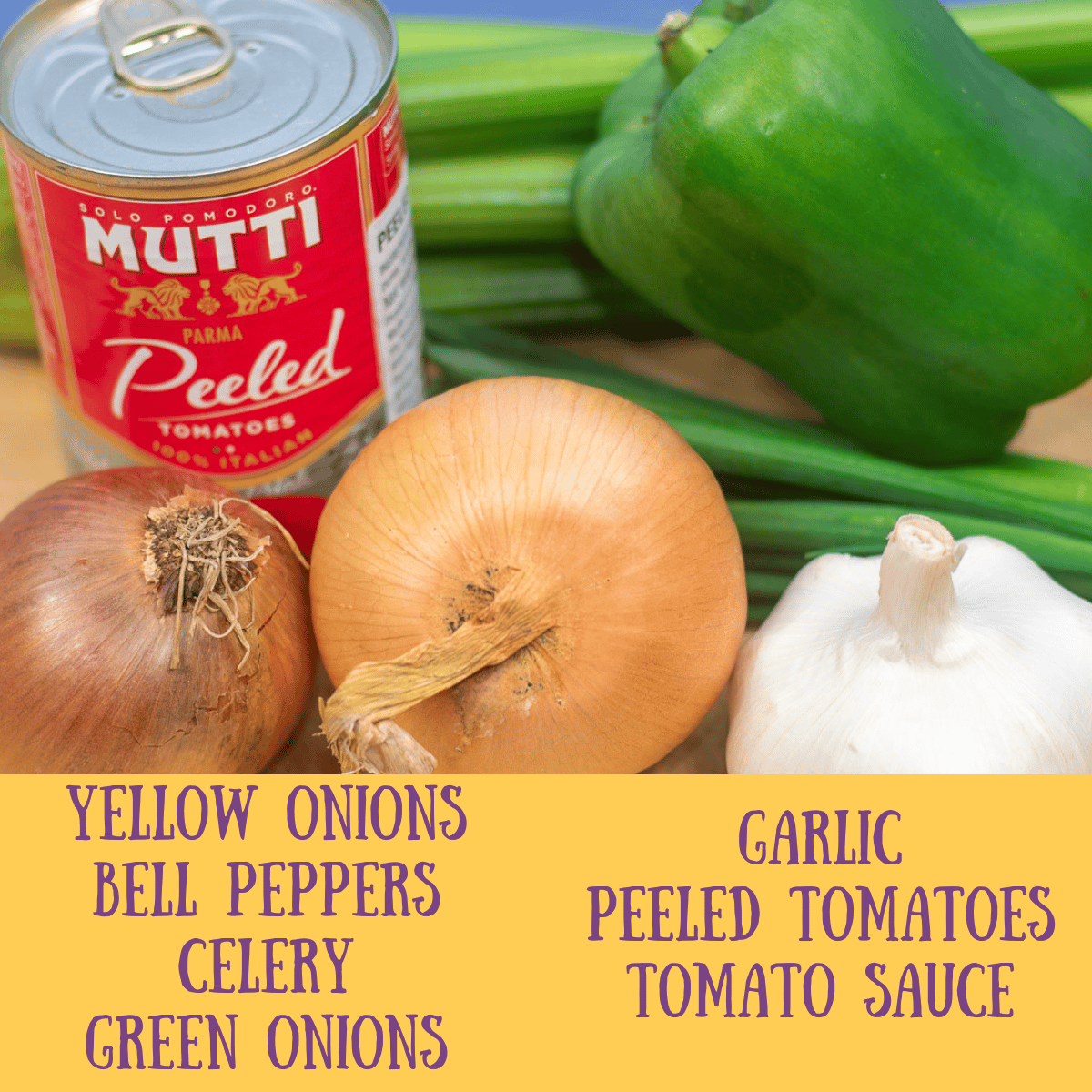
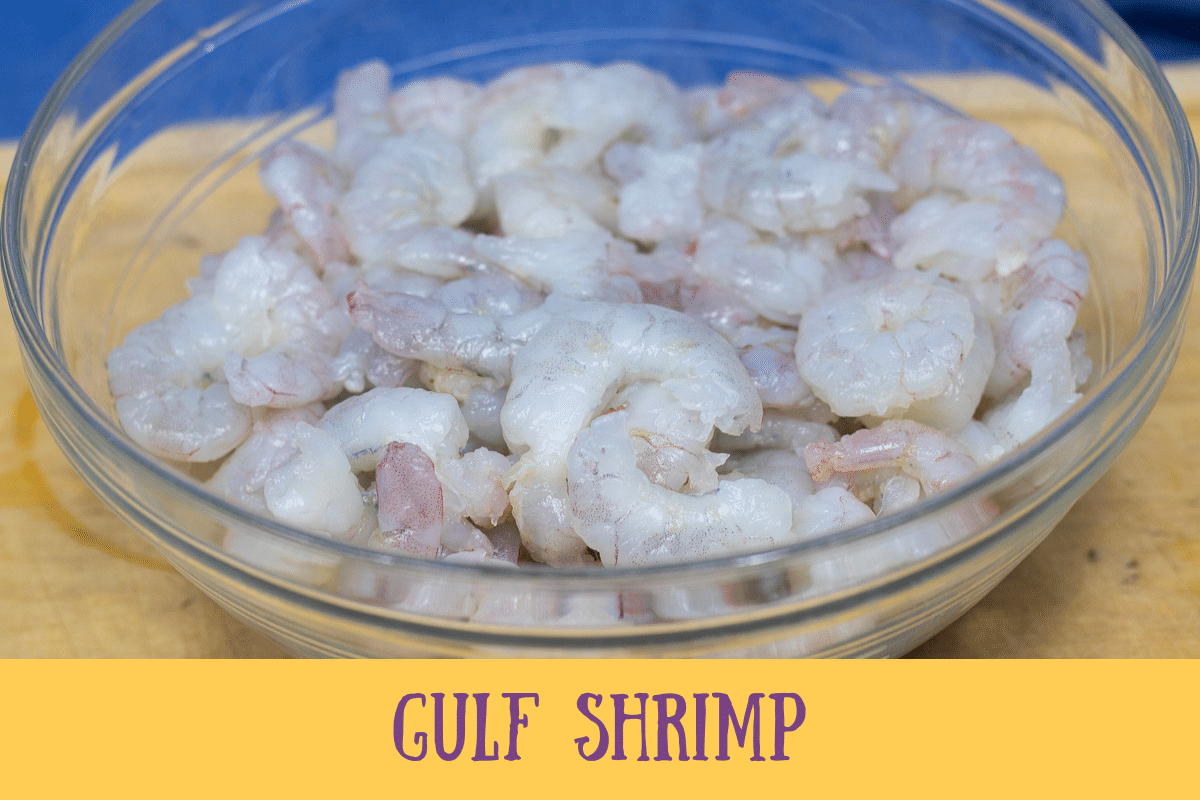
Note on shrimp: Frozen or fresh shrimp are good for this recipe. Shells and heads can be used to make Homemade Shrimp Stock. If you are buying fresh shrimp in the shell, you will have to buy more than 2 pounds to net 2 pounds of shrimp-the shells and heads add to the weight. As a rule of thumb, without heads, I buy about 2 ¾ to 3 pounds with heads. You may end up with more shrimp than you need, but they freeze well and you could have worse problems.
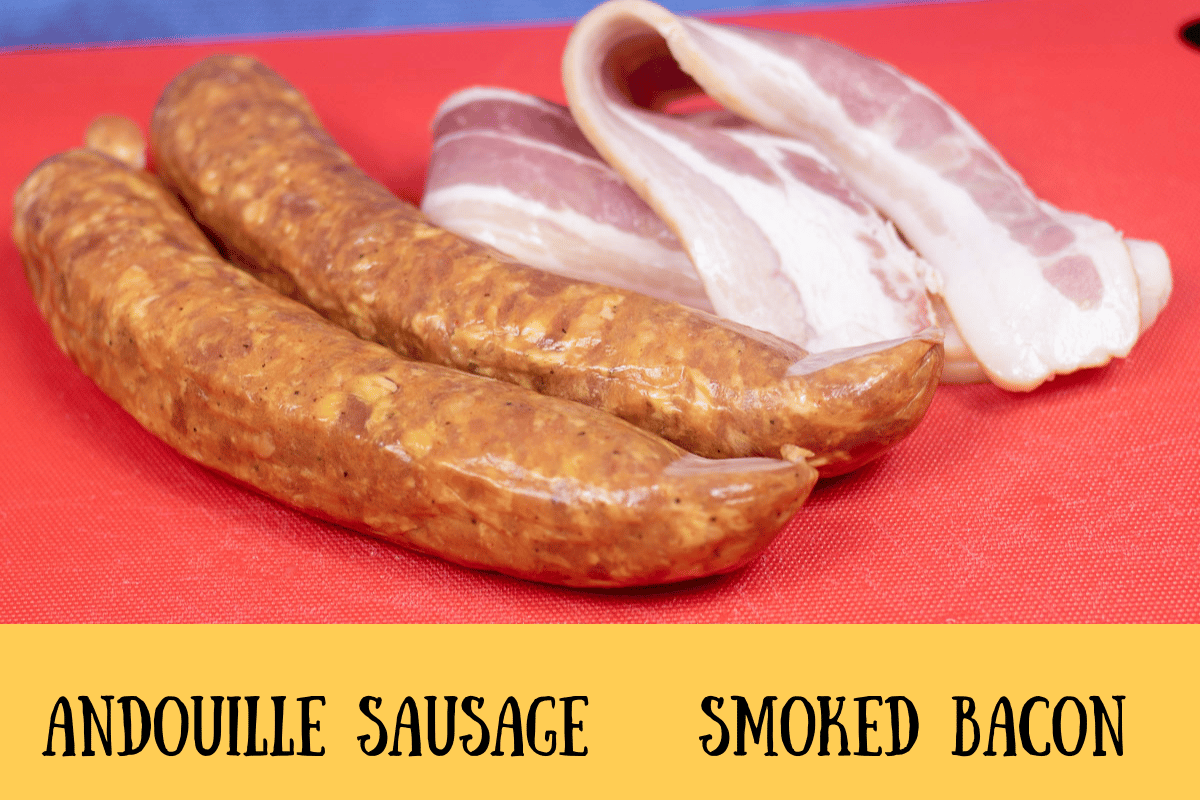
Note on sausage and bacon: The important thing is to use smoked bacon and sausage. I like smoked andouille for this recipe because it adds a distinct flavor. Kielbasa or other smoked pork sausages also work well. You can impact the flavor profile of this recipe by choosing mild or hot according to your taste preference. Use thick-cut smoked bacon so that it stands up to long cooking.
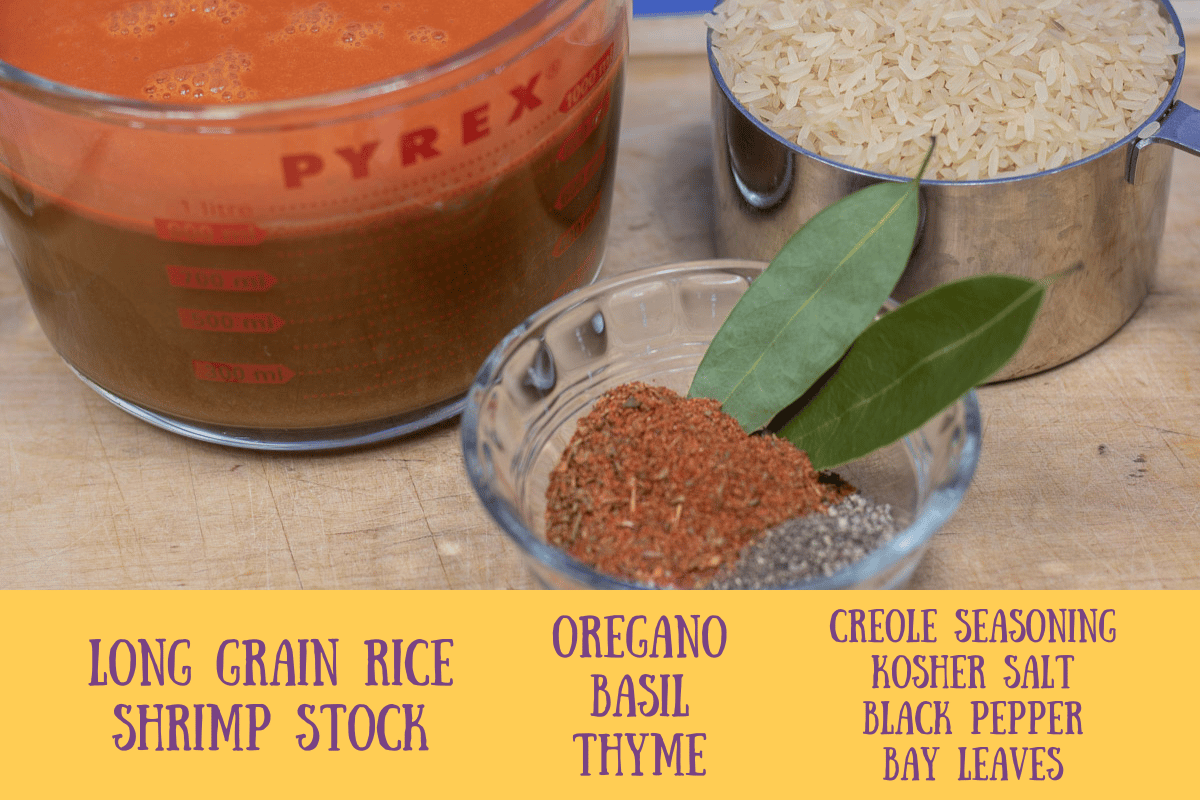
Note on tomatoes: You can use fresh tomatoes or canned tomatoes. If using fresh, make sure they are very ripe and it's best to peel and deseed them. Reserve any liquid that accumulates. If using canned tomatoes use all the liquid in the can as well. I usually use canned whole tomatoes, but chopped tomatoes also work well.
Note on rice: I use converted (parboiled) long-grain white rice for this recipe. You can also use regular long-grain rice or even Jasmine, Arborio, and Brown rice.
Note on the stock: This recipe is best when using Shrimp Stock. Check out my recipe for Homemade Shrimp Stock here. If you don't have Shrimp Stock, you can substitute Seafood Stock or Chicken Stock (my preferred substitute). As a last resort, you can use water, but that doesn't add anything to the flavor profile.

Equipment
Here is some of the equipment I used in making this recipe:
This post is not sponsored, but you will find affiliate links on this page. As an Amazon Associate, I earn from qualifying purchases. The price you pay as a consumer does not change, but I may make a small commission based on your purchase.
Here’s What You Do
First...you have a beer. I always find a jambalaya fun to cook because it often involves a crowd or get-togethers of some sort. There are only nine ingredients plus the proteins and spices and everything goes together in one pot. Simple, but you will benefit from performing mise en place. That starts with a beer. While you sip, read the recipe completely, making sure you have all the ingredients and know what to do with them.
Mise en Place
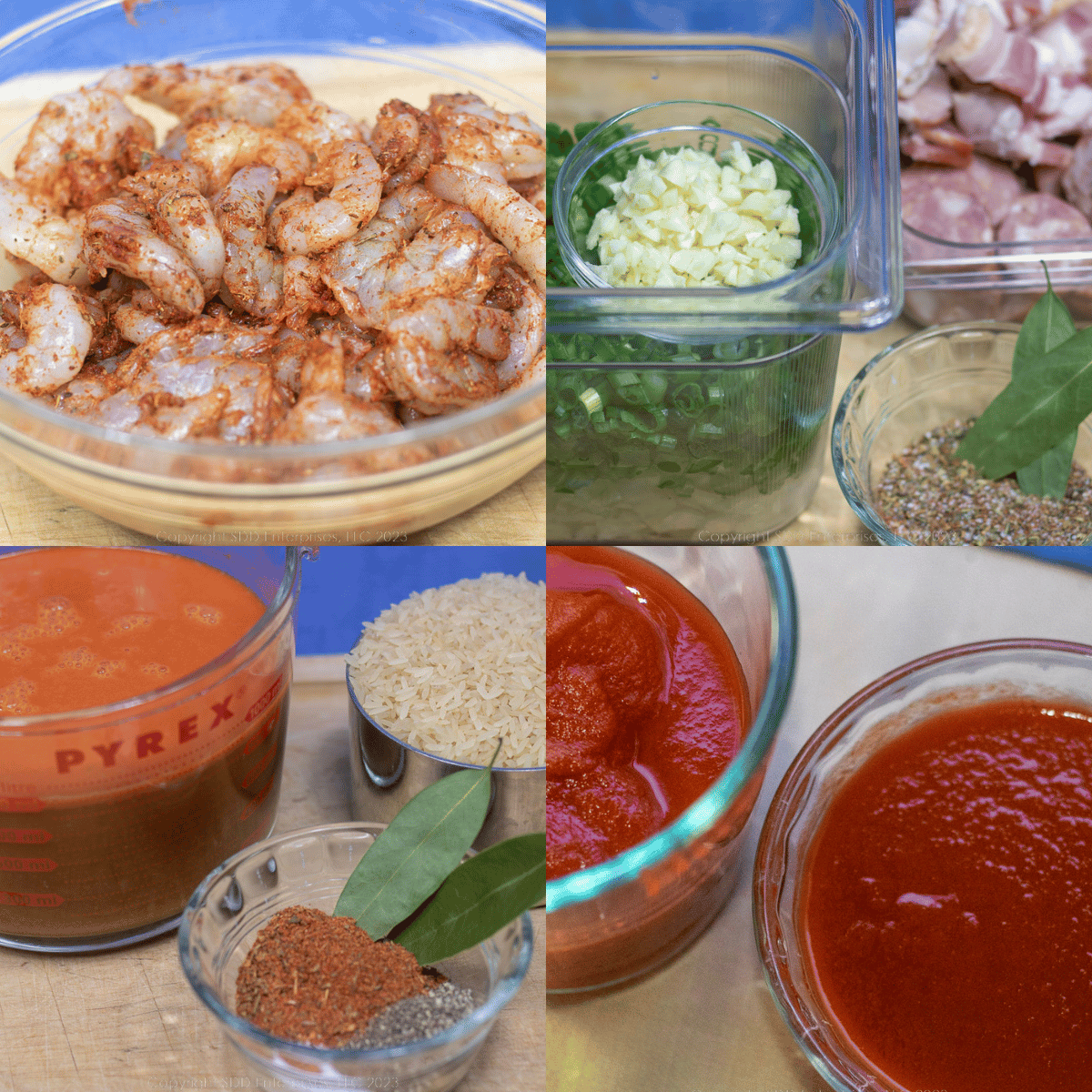
- Shrimp: If using fresh shrimp, peel, rinse and devein them. If using frozen shrimp, defrost and rinse them. Pat the shrimp dry with paper towels. Mix some Creole seasoning into the shrimp and set them in the fridge until needed.
Note on Shrimp: Save the shells to make Homemade Shrimp Stock. If you're not ready to make that yet, the shells and heads can be frozen until you need them. The cleaned shrimp, as well as the stock (if making), can be kept in the refrigerator in an airtight container for 3 to 5 days or in the freezer for a couple of months.
- Slice the sausage into ¼ inch medallions and chop the smoked bacon into 1-inch pieces. Set this aside.
- Chop the Trinity (that’s the yellow onions, bell peppers, and celery) and place it in a bowl together.
- Chop the garlic and green onions and place them in separate bowls.
- Measure the rice and stock and open the cans of tomatoes and tomato sauce. We will use all the juice in the tomato can.
Note on tomatoes: If using fresh tomatoes, make sure they are very ripe. Peel and deseed the tomatoes, reserving all the juice generated.
- Mix the Herb and Spice Blend and set it aside.
- Another sip or two of beer and you’re ready to go.
Render the fat and caramelize the Trinity
What happens in this step? Our first layer of flavor starts with rendering the fat of smoked meats and using that to cook the Trinity until the natural sugars are drawn out.
Place a large Dutch oven over medium-high heat and fry the bacon until most of the fat has been rendered. This will take about 5 minutes.
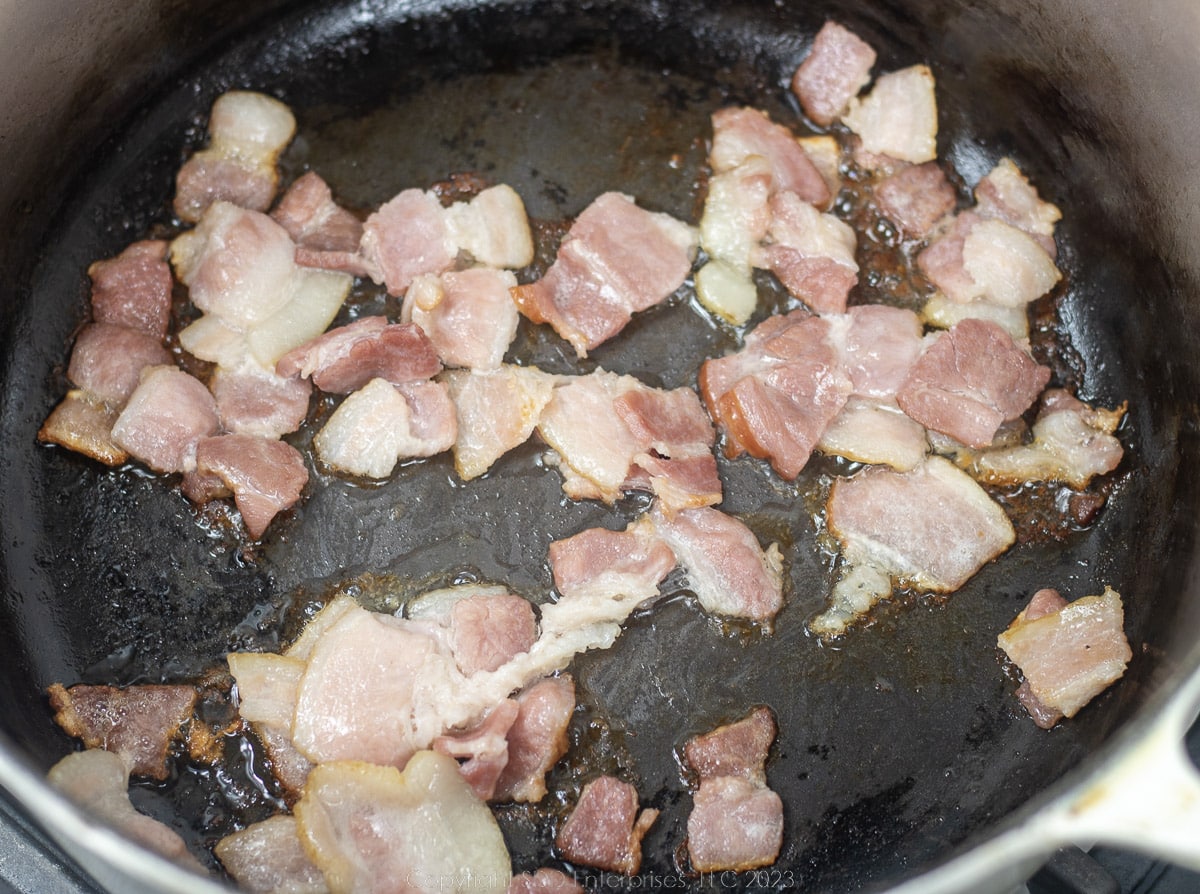
Leaving the bacon in the Dutch oven, add the sliced sausage and continue to fry until its fat is rendered, another 5 minutes, approximately.
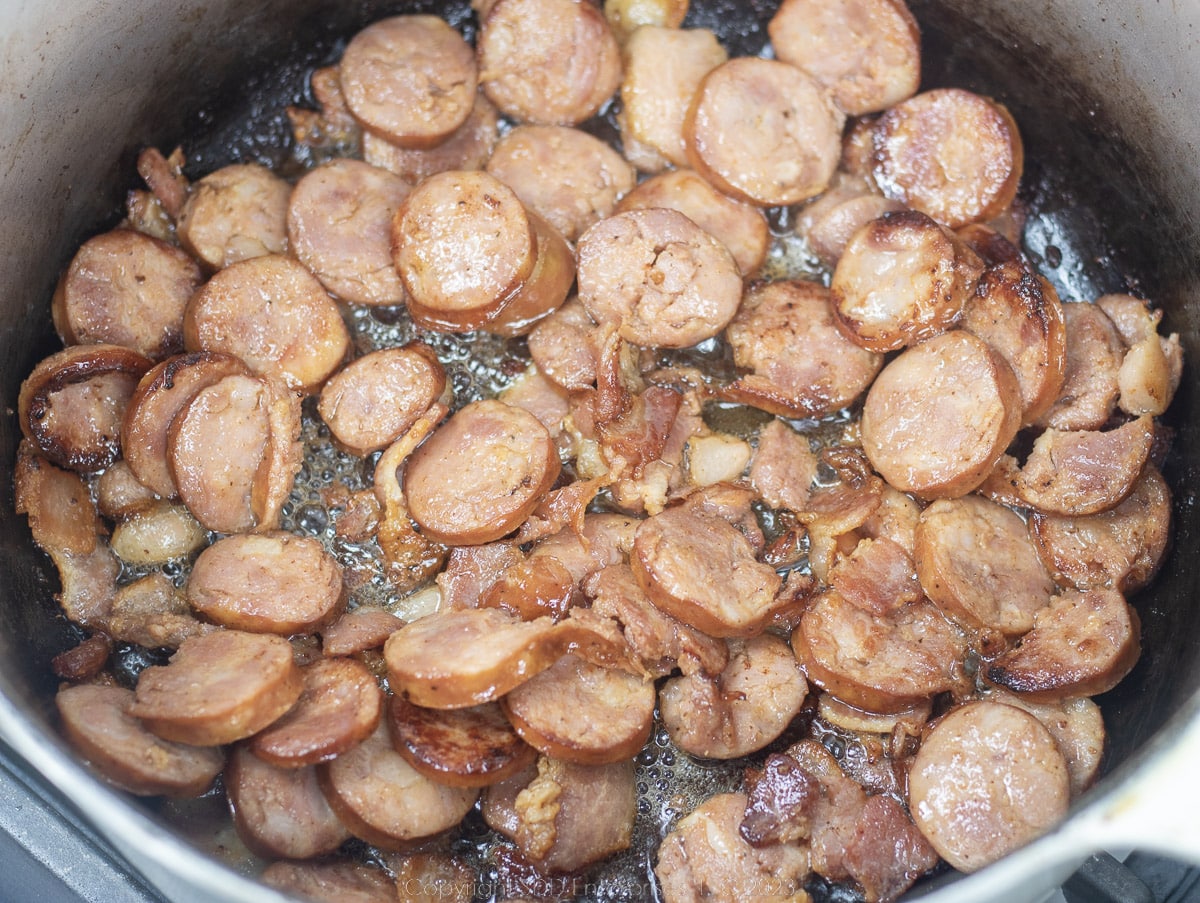
Add the Trinity (yellow onions, bell peppers, and celery) to the bacon and sausage and mix well to distribute the fat throughout the vegetables. Lower the heat to medium and continue to cook the Trinity, stirring occasionally, until they begin to caramelize and brown a little on the edges. This should take about 15 minutes.
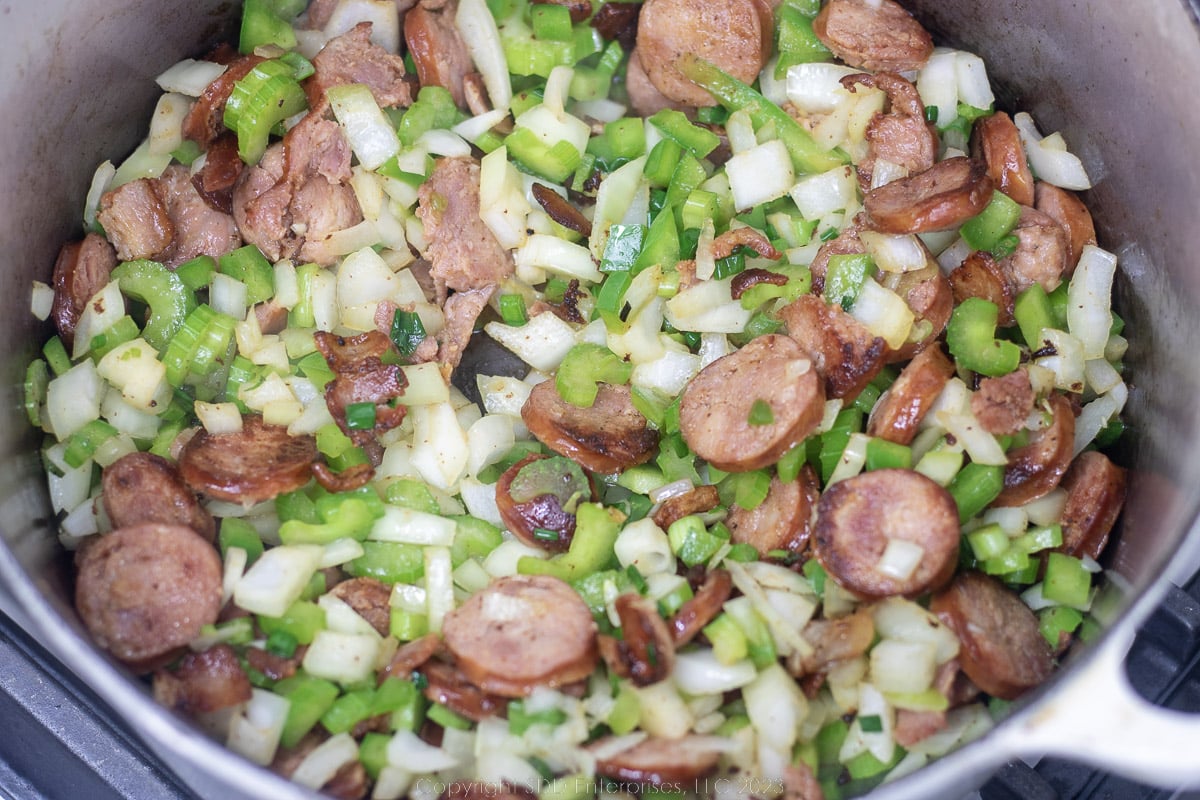
At this point, add the garlic and green onions and saute for about 2 minutes or until the garlic becomes aromatic.
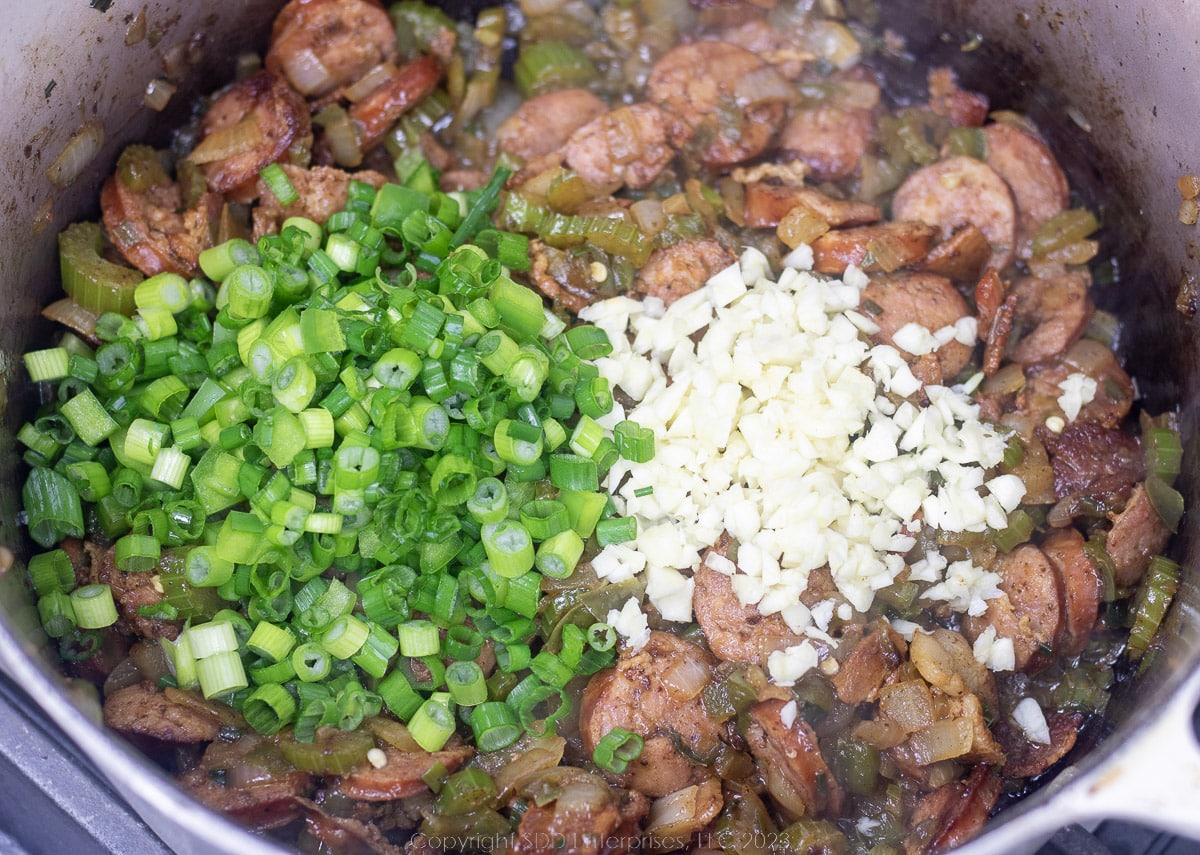
Add about ¾ of the Herb and Spice Blend and continue to saute for another couple of minutes. Reserve the remainder of the Herb and Spice Blend to add later if needed.
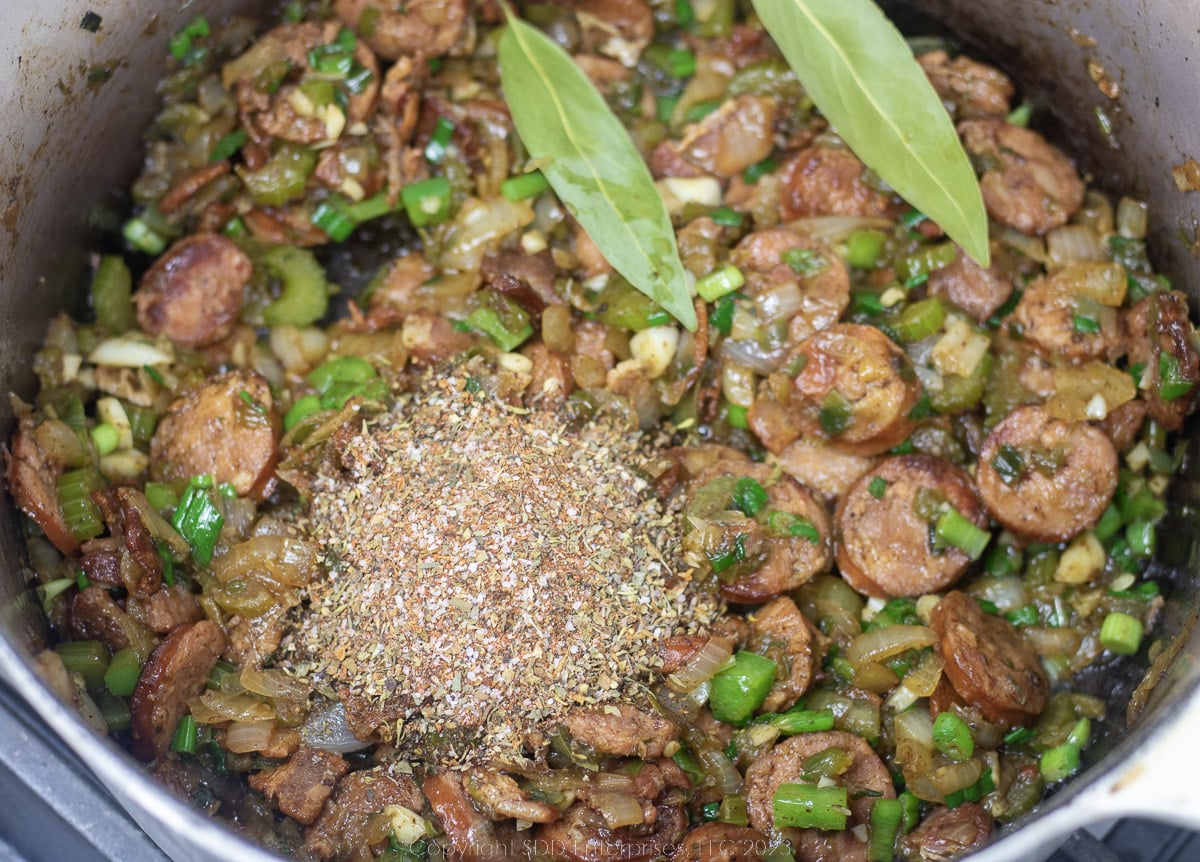
Add the tomatoes and the stock
What happens in this step? On top of the meats and Trinity, we'll add tomatoes and stock which will simmer to fuse the various flavors into one.
Next, the whole tomatoes go in. Crush each tomato by hand as you add them, along with all the juice, to the vegetables and meats. Mix well and bring it to a heavy simmer for 5 minutes.
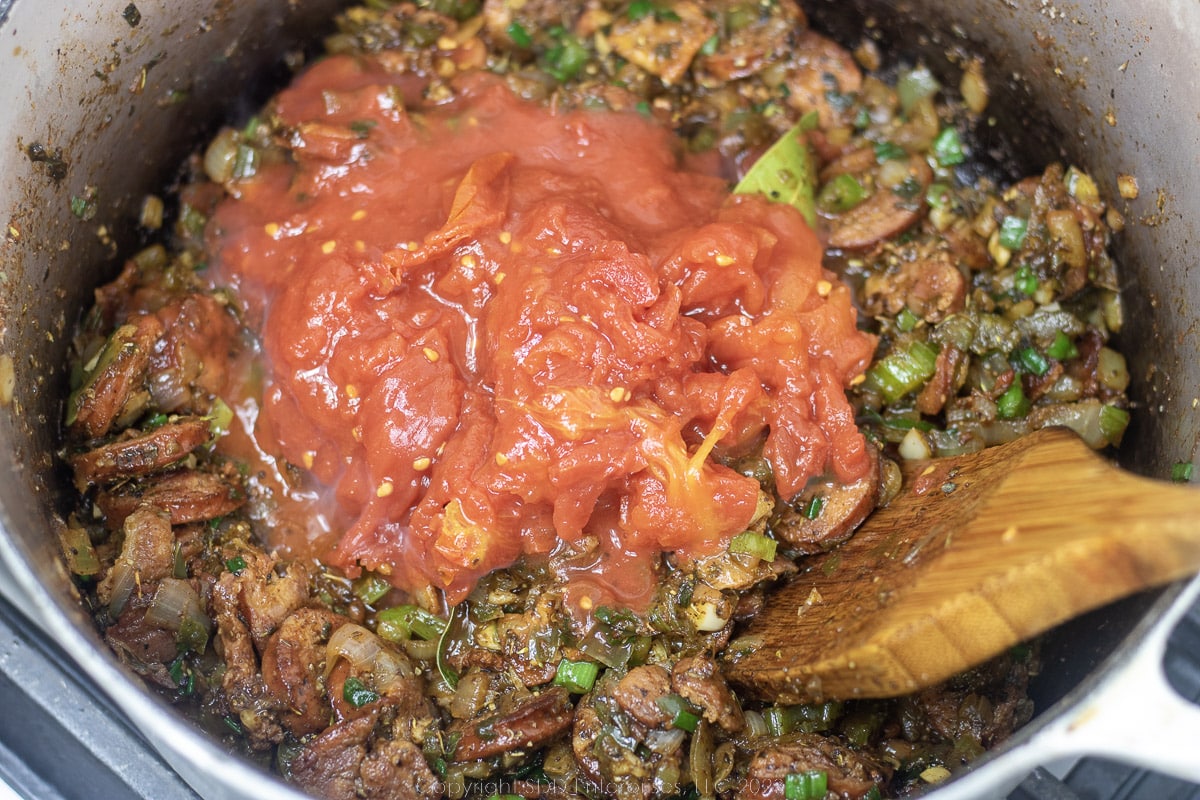
Add the tomato sauce and mix well.
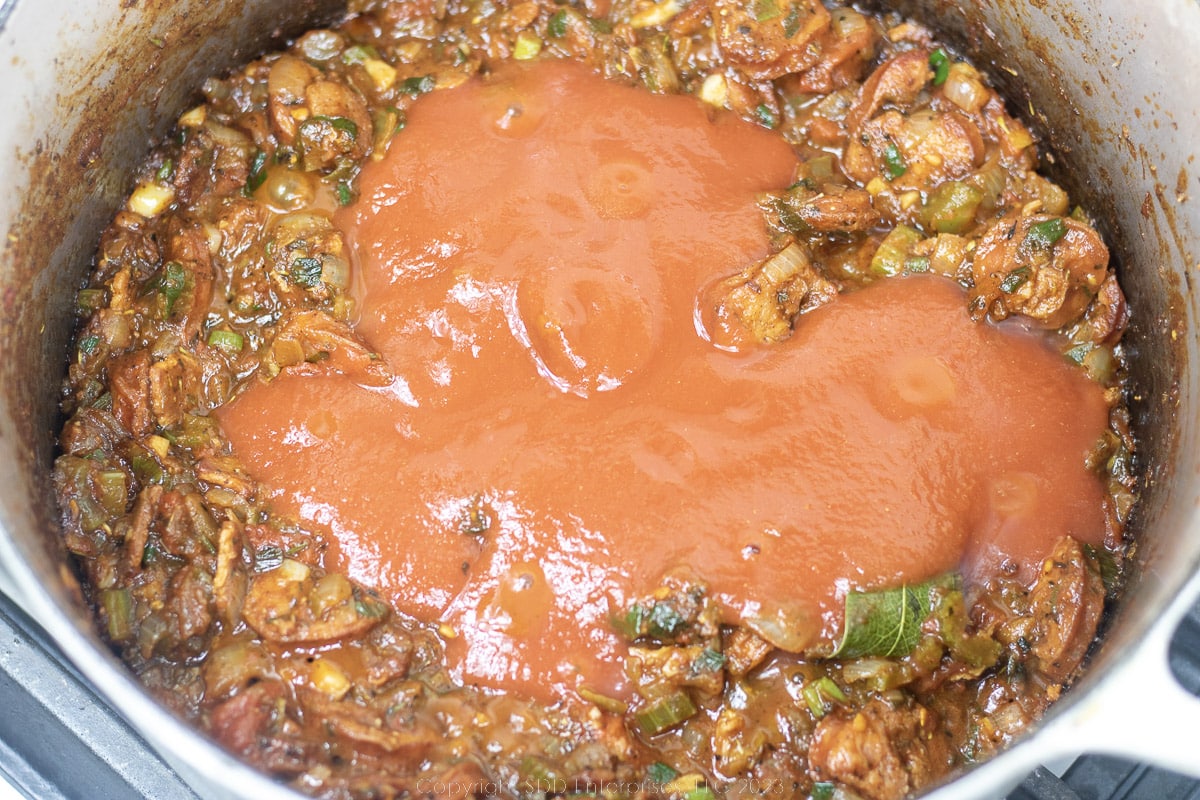
Next, add the stock (have a little more stock on hand in case you need to add some later) and bring everything to a boil. Reduce the heat to a heavy simmer, uncovered, for about 10 minutes while all the flavors get to know each other.
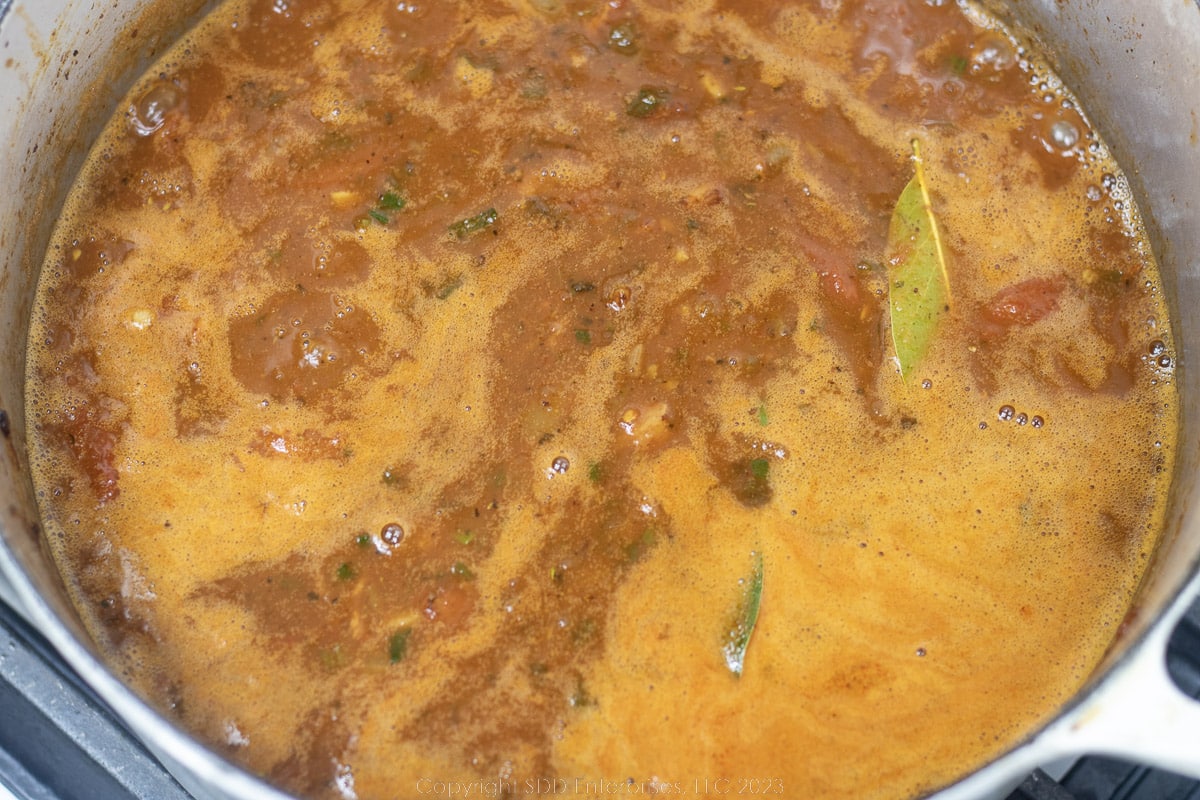
Add the Rice, then the Shrimp
What happens in this step? Now that we have a homogenous liquid simmering, we'll add the rice which will absorb the liquid and all that wonderful flavor. The shrimp will be added late in the process so as not to overcook.
After simmering for 10 minutes, increase the heat and mix in the uncooked rice, stirring thoroughly to evenly distribute the uncooked rice.
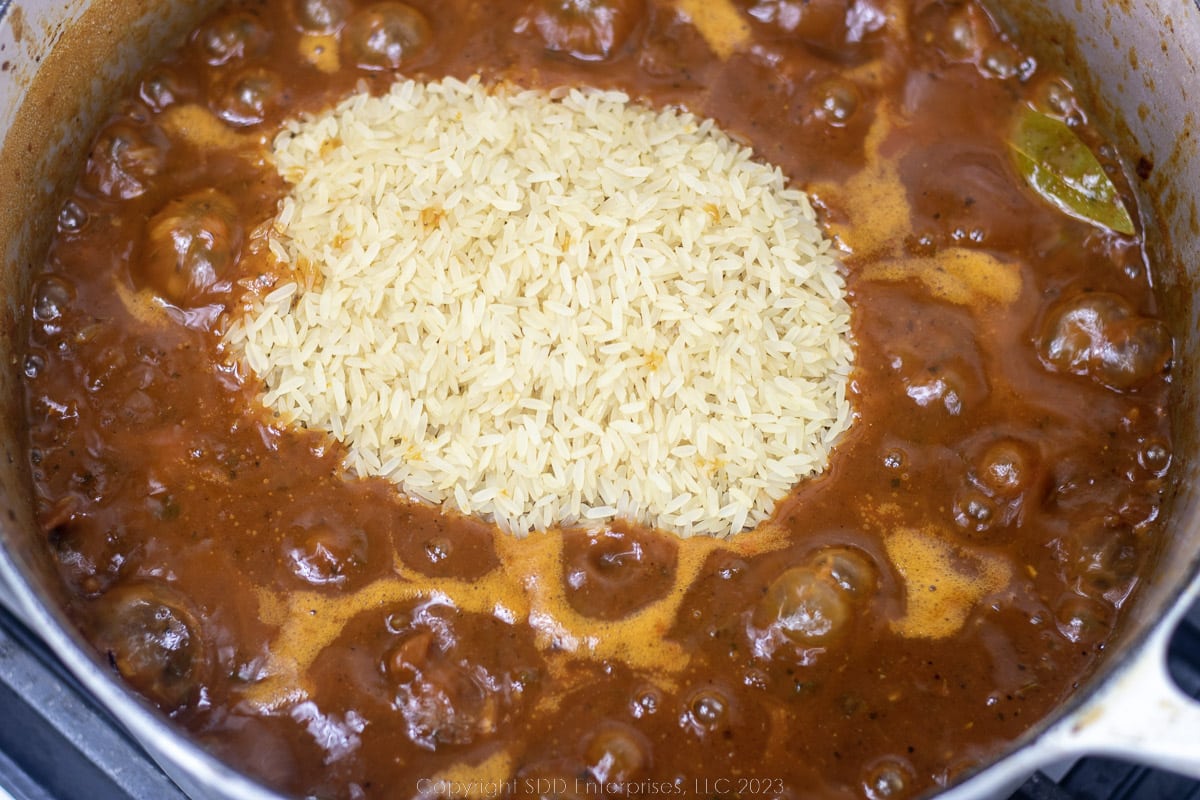
Allow the pot to return to a boil, then reduce the heat to a low simmer. Cover the Dutch oven and let it simmer for 15 minutes. During this time, do not take the lid off the Dutch oven.
Pro Tip: We want to give the rice time to cook evenly and absorb the flavor-packed liquid. Leaving the lid in place will promote the creation of steam as the mixture simmers on low. In this environment, all of this moisture will be absorbed by the rice. Removing the lid during this time will make the rice cook unevenly.
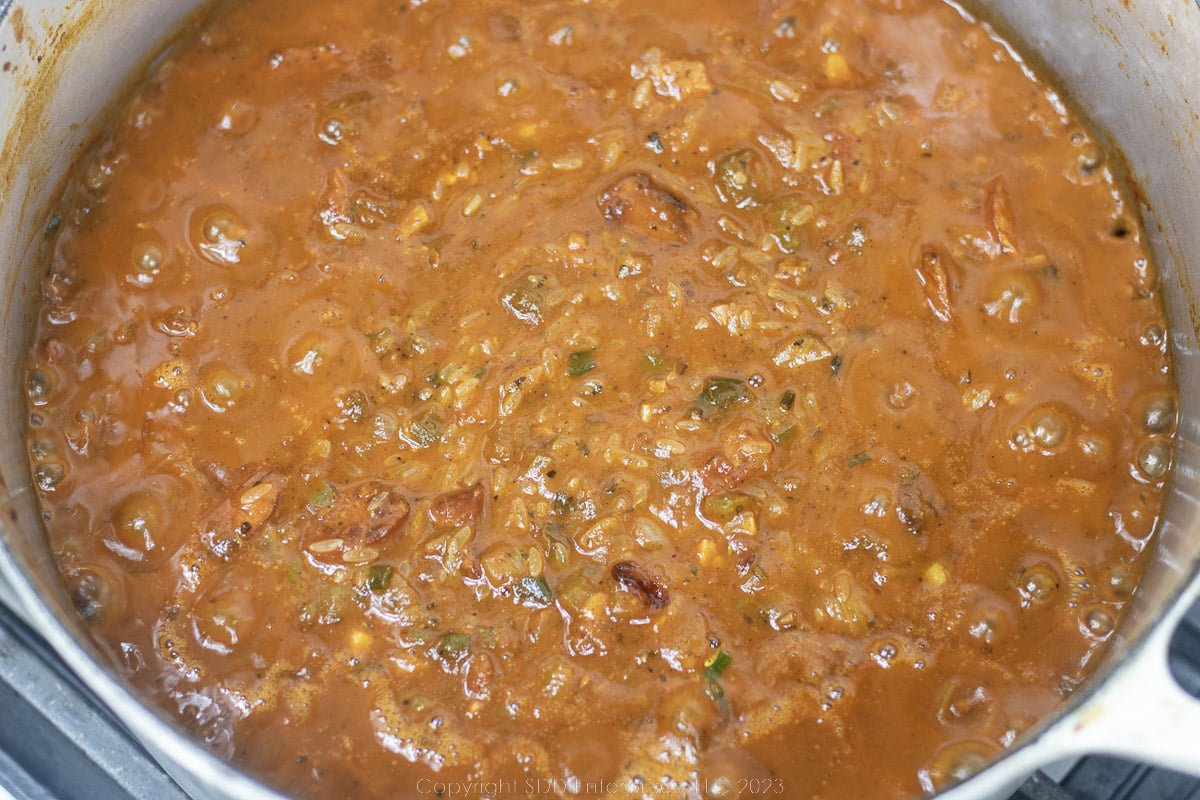
After 15 minutes, remove the lid and give the pot a thorough stir.
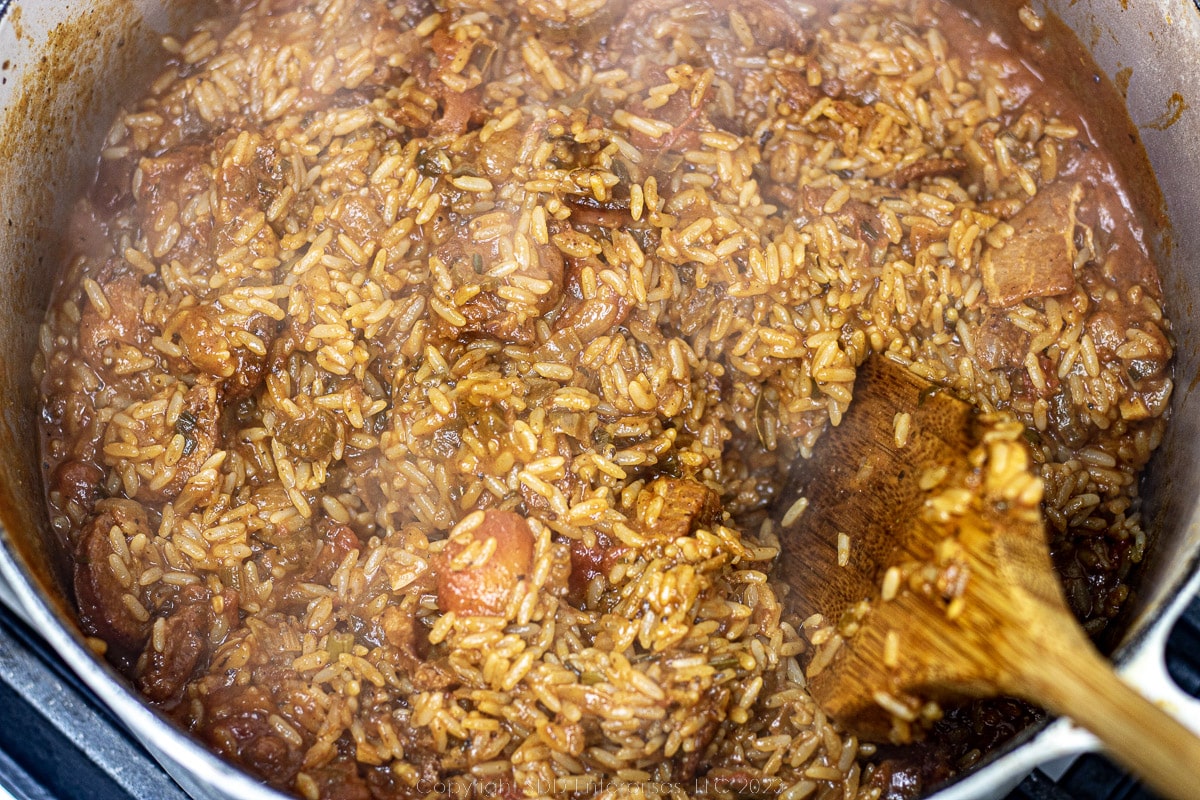
Add the shrimp a few at a time, stirring to combine the shrimp and rice completely.
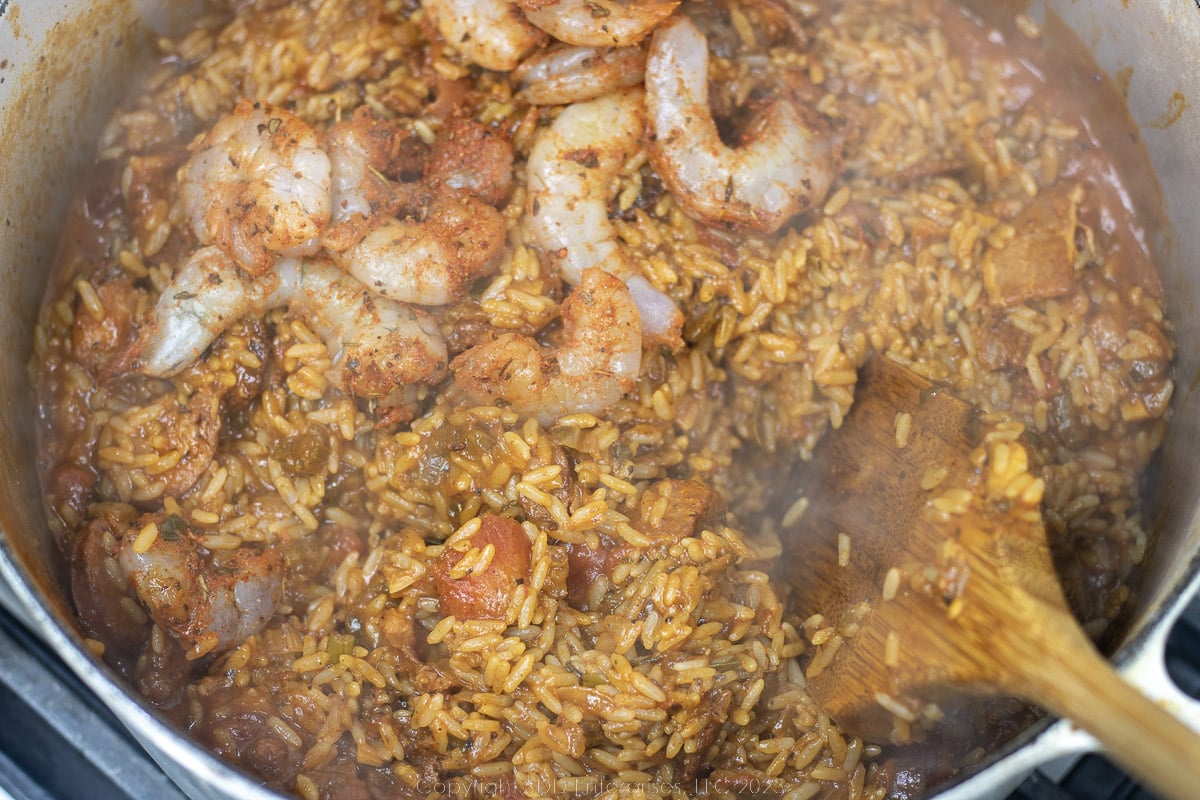
Replace the lid and simmer for an additional 15 minutes (again, do not open the lid during this time). After 15 minutes, remove the lid and test the rice for doneness and seasoning. If the rice is cooked, the jambalaya is done. If the rice is still a little hard, replace the cover and simmer for up to an additional 5 minutes or until the rice is done. If more liquid is needed, add some of the reserved stock. Pay attention because you don’t want the rice overcooked and mushy. Add some or all of the reserved Herb and Spice Blend as needed. Once done, remove the Dutch oven from the heat and let it sit covered for another 5 minutes. Fluff it up, remove the bay leaves and you are ready to geaux!
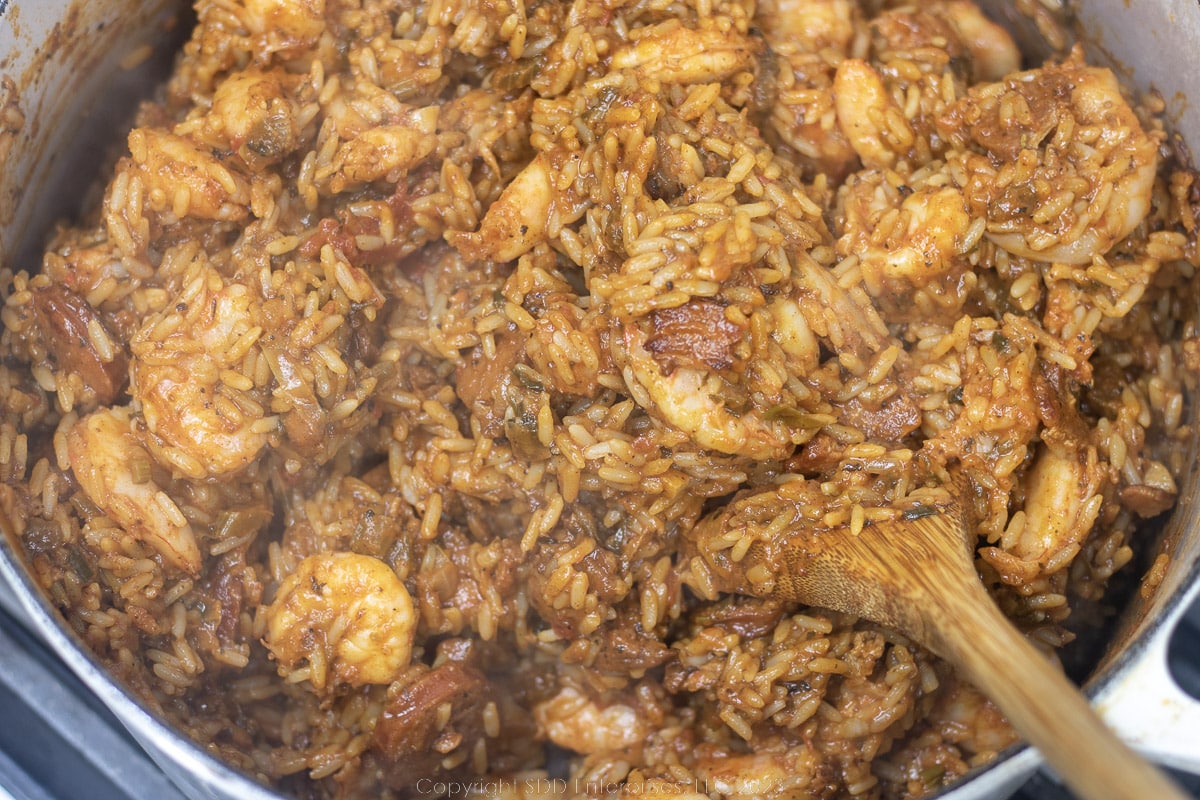
That’s it, all there is to it.
Sign up for my email notifications of new recipes and posts right HERE.
Hints and Tips (FAQs)
Long-grain white rice is what is normally used. Other rice, like Jasmine, Arborio, and Brown rice are also options. Differing cooking times of the various kinds of rice should be considered when choosing your rice. I commonly use parboiled rice, such as Uncle Ben’s Converted Rice, which cuts the cooking time slightly, but regular long-grain rice is perfect for this recipe as well. Keep in mind, many factors can affect cooking time, such as altitude, so it's important to test the jambalaya after cooking for 30 minutes. The Jambalaya is ready when the rice is done.
Andouille sausage is highly seasoned (that doesn’t mean it’s always spicy), coarse-grained, smoked pork sausage which is very common in Cajun and Creole recipes. Any smoked pork sausage, like kielbasa, can be substituted for the andouille, but keep in mind that the andouille adds a lot of flavors that other sausages do not. In addition to smoked sausage, you can also add some smoked ham or tasso to the recipe.
Frozen shrimp, sold in many grocery stores and seafood markets, are perfectly good in this recipe. Make sure to thaw the shrimp in the refrigerator overnight and rinse before using. Pat the rinsed shrimp dry with a paper towel and sprinkle on some Creole seasoning, Set the seasoned shrimp aside and they will be ready when you are.
The shrimp do not have to be large. Medium shrimp (41/50 count) work well, but small shrimp will work if that's all you can find. The term “count” refers to the number of shrimp in a pound. In this example, the shrimp are a size that is between 41 and 50 shrimp would weigh one pound. Learn a little more about shrimp sizes by reading my article, What Size Shrimp Do I Need?
Leftovers will last about 3 to 4 days in the refrigerator and should be stored in an airtight container. Reheat the Jambalaya in the microwave or on top of the stove. Add a little water to the Jambalaya then reheat slowly, stirring occasionally until warmed through.
Creole jambalaya does not freeze well because the rice will tend to get mushy. If you do freeze the leftover jambalaya make sure to use an airtight container or a vacuum sealer for best results. Defrost in the fridge overnight.
If you want to cook this ahead of time, consider cooking up to the point just before you add the rice. Freeze the mixture in an airtight container and when you are ready to eat, thaw it in the refrigerator overnight, then bring it to a boil and add the rice and shrimp as the recipe directs.
Other popular Cajun and Creole dishes such as Gumbo, Etouffee, Shrimp Creole and Dirty Rice are completely different than both Cajun and Creole Jambalaya. Jambalaya, as you have just read, is seasoned proteins and vegetables cooked in a rich stock with uncooked rice until the rice absorbs all the wonderful flavors. Shrimp Creole and any Etouffee are highly seasoned sauces that are served over rice. Dirty Rice utilizes cooked rice blended into seasoned meat with chicken organ meat, a perfect use for left-over rice. Gumbo, of course, is a soup-like combination of proteins and vegetables that is often served with a scoop of cooked rice as an add-on. All are unbelievably delicious and come with a Cajun or Creole cook ready to argue with you about what you should put in each one!
Take a look at these great related Cajun and Creole recipes...try them all!
If you make this recipe:
- Tell us about it in the Comments section below
- LEAVE A RATING ON THE RECIPE-worthy of 5-Stars?
- Questions or Comments? that’s the place!
- SIGN UP FOR OUR EMAIL UPDATES so you don't miss anything!
- Post a picture and share it with your friends on our Social Media:
Yeah You Right!
Recipe
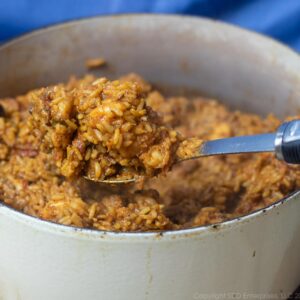
Creole Jambalaya
Here's What You Need
- 2 pounds shrimp peeled, deviened, and rinsed
- 2 strips smoked bacon sliced into 1" pieces
- 1 pound andouille sausage sliced into medallions
- 2 medium yellow onions chopped
- 1 small green pepper chopped
- 2 stalks celery chopped
- 1 bunch green onions chopped
- 5 cloves garlic chopped
- 15 ounces whole peeled roma tomatoes See Recipe Notes
- 8 ounces tomato sauce
- 2 cups long-grain rice See Recipe Notes
- 3 ½ cups shrimp stock See Recipe Notes
Herb and Spice Blend
- 1 teaspoon oregano
- 1 teaspoon basil
- ½ teaspoon thyme
- 1 tablespoon Creole seasoning plus some for the shrimp
- 2 teaspoons kosher salt
- 2 teaspoon ground black pepper
- 2 bay leaves
Here's What You Do
Prep the Ingredients
- Peel, devein, and rinse the shrimp. Pat dry with paper towels and mix about 1 tablespoon of Creole seasoning into the shrimp and place in refrigerator until needed.
- Slice the bacon and sausage, chop the yellow onions, bell peppers and celery; chop the green onions and garlic; measure the stock, rice and Herb and Spice Blend; open the cans of whole tomatoes and sauce. Set all aside until needed.
Make the Jambalaya
- Fry the bacon in a Dutch oven over medium heat to render the fat, about 5 minutes.
- Add sausage and saute to render the fat, about 5 minutes.
- Add the Trinity (yellow onions, bell peppers and celery) and saute until starting to caramelize, about 15 minutes.
- Add garlic and green onions; saute about 2 minutes
- Add about ¾ of the Herb and Spice Blend plus the Bay Leaves; stir to mix for 2 to 3 minutes.
- Add the tomatoes by crushing each tomato by hand as you add them. Add in any juice from the tomatoes.
- Increase the heat to a heavy simmer for 5 minutes, then add the tomato sauce and stock.
- Stir well and bring it to a heavy boil, then reduce the heat to a strong simmer and cook uncovered for about 10 minutes while all the flavors merge. Taste for seasoning and adjust if necessary.
- Mix in the raw rice and return to a boil before reducing the heat to a simmer. Cover the Dutch oven and cook for 15 minutes. Do not open the lid during this period.
- After 15 minutes, remove the lid, stir well. Add the shrimp, a few at a time, and stir to combine completely.
- Replace the lid and simmer for an additional 15 minutes, again, do not open the lid during this period.
- After 15 minutes, remove the lid to test the rice for seasoning and doneness. If the rice is still a little hard, replace the cover and simmer for up to an additional 10 minutes or until the rice is done. Test after 5 minutes. Adjust seasoning, if needed.
- Remove the Dutch oven from the heat. Let it sit covered for another 5 minutes. Remove the bay leaves and serve.
Recipe Notes
Nutrition Estimate
Publishers Note: This article was originally published in February 2020. This update is intended to improve your experience in search and navigation with updated information and images.

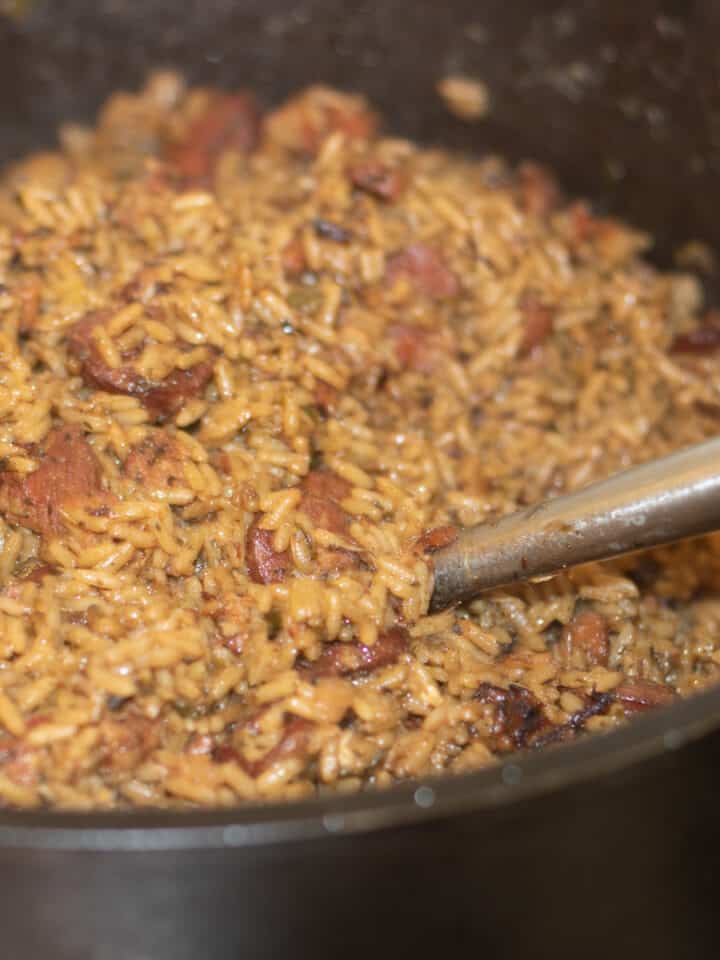
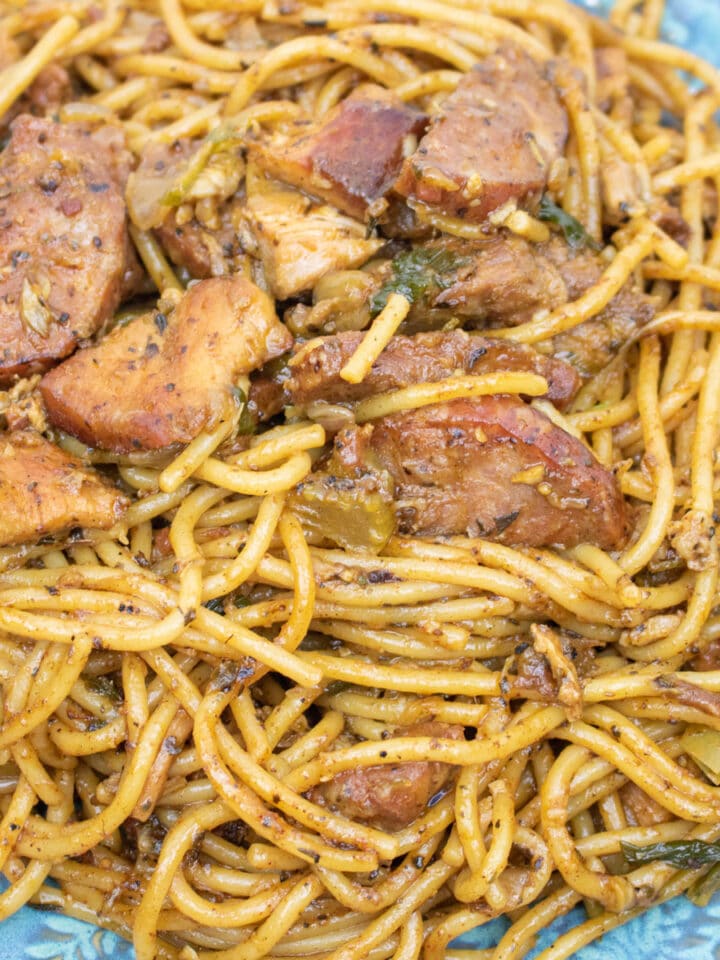
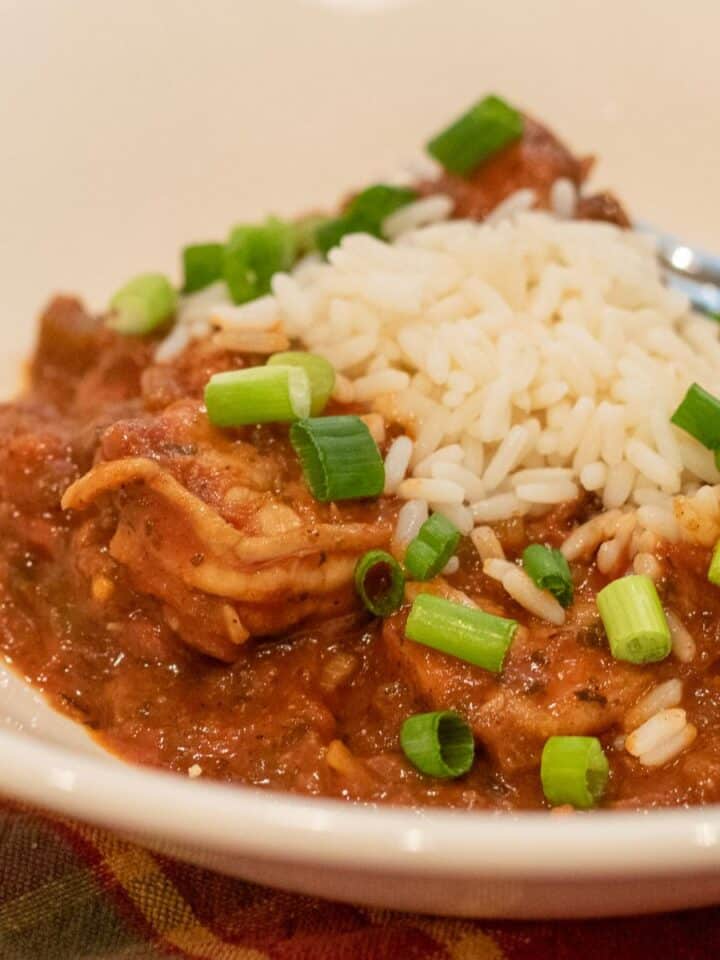
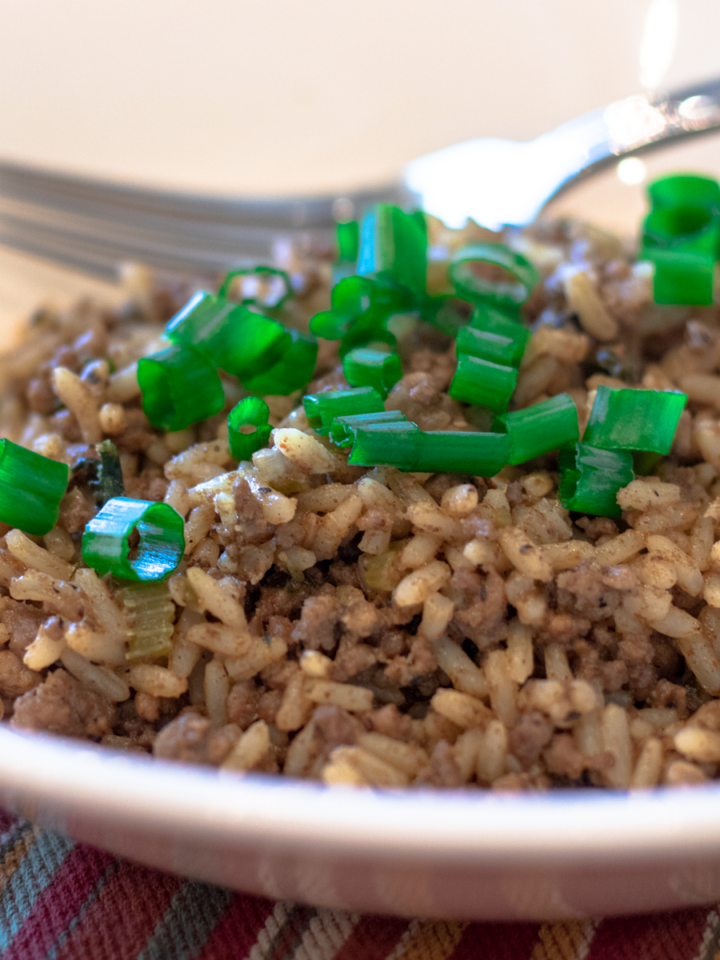
Mac
Hey man, this looks delicious and I'm excited to make it. I had a Jambalaya with chicken in it once and I'm not a big bacon guy, do you think this would be good with chicken instead? Thanks!
Sweet Daddy D
Hey, Mac. You can skip the bacon, just use a small amount of vegetable oil to get going. If you want a jambalaya with chicken, you should try my Cajun Jambalaya?
Robert
Just about the best thing I ever made
Sweet Daddy D
Yeah you right, Robert! Thanks.
Junius Arceneaux Jr.
Ok Sweet Daddy
I would like to know if you have a list of ingredients to cook up a 20 quart of your CREOLE JAMBALAYA. I can make the Cajun Jambalaya with my list, but I am wanting to try your recipe with shrimp and make a red Jambalaya. Thanks for your help. I going to get me a beer while waiting for your reply.
Sweet Daddy D
Hey, my friend. I'm going to send you an email.
Tim Melancon
I am interested in making a 20 gallon black iron pot creole jambalaya. Would you have a recipe for this big of a batch of jambalaya? I’ll have a beer while waiting as well.
Sweet Daddy D
Hi, Tim. I responded to you via email.